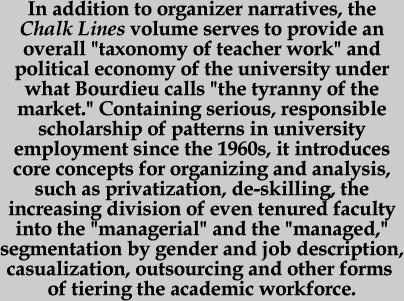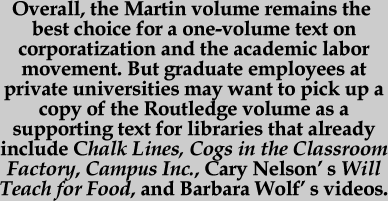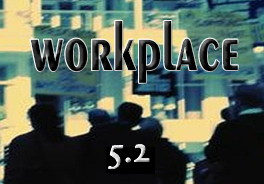|

The Academic Labor
Movement in One Volume
Chalk Lines: The Politics of Work
in the Managed University. Ed. Randy Martin.
Duke University Press, 1998
Steal
This University: The Rise of the Corporate University
and the Academic
Labor Movement. Eds. Benjamin Johnson, Patrick
Kavanagh, and Kevin Mattson.
Routledge, 2003
Marc Bousquet
1.1 Readers
looking for a single volume addressing the “rise of the corporate university
and the academic labor movement" will probably continue to turn to Randy
Martin’s superb Chalk Lines: The Politics of Work in the Managed University
(Duke, 1998). An exceptionally diverse collection of contributions by
labor historians, sociologists, specialists in higher education, theorists
and organizers, Chalk Lines addresses the organizing experiences of
traditional faculty, graduate employees, and adjunct lecturers,
as well as undergraduates. It emphasizes public higher education and the
connections between different sites of struggle, including the public-policy
arena affecting such specific campus constituencies as the adult learners
served by adult literacy education centers.
organizers, Chalk Lines addresses the organizing experiences of
traditional faculty, graduate employees, and adjunct lecturers,
as well as undergraduates. It emphasizes public higher education and the
connections between different sites of struggle, including the public-policy
arena affecting such specific campus constituencies as the adult learners
served by adult literacy education centers.
1.2 In addition to organizer narratives, the Chalk Lines volume serves
to provide an overall “taxonomy of teacher work” and political economy
of the university under what Bourdieu calls “the tyranny of the market.”
Containing serious, responsible scholarship of patterns in university
employment since the 1960s, it introduces core concepts for organizing
and analysis, such as privatization, de-skilling, the increasing division
of even tenured faculty into the “managerial” and the “managed,” segmentation
by gender and job description, casualization, outsourcing and other forms
of tiering the academic workforce. Taking a global perspective that includes
Canadian and Australian as well as U.S. campuses, the volume presents
indispensable analysis of the phenomenon dubbed “academic capitalism”
by Sheila Slaughter and Gary Rhoades, describing both the rise of for-profit
education and the increasing willingness of traditional universities to
adopt for-profit methods, including the privatization of many public functions,
and the steady growth of market behaviors in the faculty as a result of
Toyotist innovations by university management. This market behavior includes
competition between colleagues for grants, released time, “merit pay,”
lab time and other resources; the speed-up of faculty work processes;
increased responsiveness to managerial command; re-direction of loyalties
from the profession at large to an individual employer or academic unit;
and an increasing tendency to value research in relation to its revenue
potential and not the public good. At present, for instance, 90% of medical
research dollars flow toward diseases experienced by the wealthiest 10%
of the world’s population.
1.3 Those readers looking to supplement the organizing narratives in Chalk
Lines might want to turn to Barbara Wolf’s brilliant two-cassette
documentary film, A Simple Matter of Justice: Contingent Faculty Organize
(2001) which provides a five-part follow-up of her path-breaking Degrees
of Shame (1997) (both available at: br_wolf@hotmail.com), or the new
volume by Julie Schmid and Deborah Herman, Cogs in the Classroom Factory:
The Changing Identity of Academic Labor (Greenwood, 2002), featuring
a foreword by David Montgomery. Those looking for a multi-volume experience
of the core issues of the academic labor movement will certainly want
to look at other work published by Slaughter and Rhoades, especially Slaughter’s
collaboration with Larry L. Leslie, Academic Capitalism: Politics,
Policies and the Entrepreneurial University (Hopkins,1997) and Rhoades’
indispensable study of faculty unionism, Managed Professionals: Unionized
Faculty and Restructuring Academic Labor (SUNY, 1998). Those looking
for more detail on “corporate power in the ivory tower” might turn to
Aronowitz’s Knowledge Faculty Dismantling the Corporate University
and Creating True Higher Learning (Beacon 2000), the compelling collection
gathered together by Geoffry White in Campus, Inc. (Prometheus
2000), or Bill Readings’ influential discussion of university as a transnational
bureaucratic corporation and its managerial rhetoric of “excellence,”
The University in Ruins (Harvard,1996). Some of the essays originally
published in three influential double issues of minnesota review
on academic labor have been reprinted in Jeff Williams’ 2002 SUNY volume,
The Institution of Literature. You might also continue to read
Workplace and the website of the Coalition of Graduate Employee
Unions (www.cgeu.org).
x x x
2.1 The more recent volume by Routledge, despite its encompassing subtitle,
primarily features the perspective of graduate employee unionists at private
institutions, especially at NYU and Yale: with a couple of exceptions,
the volume’s discussions of tenure stream faculty tend to feature them either as successful
job candidates (“the winners of the academic lottery”), or in supporting
roles to graduate-employee organizing, such as Cary Nelson’s discussion
of the MLA Graduate Student Caucus and the compelling account—previously published in Workplace—by Joel Westheimer of NYU’s wrongful denial of his tenure case in connection with his support of graduate student unionism (http://www.louisville.edu/journal/workplace/wp42.html).
 2.2 While this perspective will resonate with some readers, the volume’s version of “the academic labor movement” scants the overwhelming reality of faculty unionism (nearly half of all tenure-stream faculty are unionized; including almost 2/3 of the faculty in public higher education, much more, if the top 100 research universities are excluded). Higher education faculty are three
times more likely to be unionized than the average American worker. 2.2 While this perspective will resonate with some readers, the volume’s version of “the academic labor movement” scants the overwhelming reality of faculty unionism (nearly half of all tenure-stream faculty are unionized; including almost 2/3 of the faculty in public higher education, much more, if the top 100 research universities are excluded). Higher education faculty are three
times more likely to be unionized than the average American worker.
2.3 As I wrote in the foreword to the first volume of Workplace (http://www.workplace-gsc.com/workplace1/wokplace.html),
I happen to agree with the volume’s editors that the graduate employees
and former graduate employees working off the tenure track have the best
standpoint from which to describe the most just solution to the problems
of academic labor (see my “The ‘Waste Product’ of Graduate Education:
Toward a Dictatorship of the Flexible.”). But I make that claim for what
I call the “third wave” of consciousness in relation to the academic labor
movement in connection with the “first wave” of tenure-stream unionism,
which has had notable successes as well as failures (especially in failing
to address casualization), and in relation to the second wave of managerial
consciousness (charted by the critical scholarship of Slaughter, Rhoades,
and others collected in the Martin volume), a subset of which was the
1980s phenomenon of “job market theory,” made popular by the MLA staff
and such bad scholarship as the 1987 Bowen report (which predicted twenty
years of “job surplus” beginning in the late 1990s!).
2.4 The absence of a coherent critical narrative of changes in higher education
ultimately cripples the Routledge volume for purposes of analysis: its
section analyzing the “rise of the corporate university” consists of just
four essays, one of them a reprint of David Noble’s “Digital Diploma Mills,”
widely circulated on the internet six years ago. While an important document
regarding the mid-1990s managerial dreamscape for the application of technology
to the academy—of dollars for credits without faculty labor time--the
Noble essay’s weakest point is its narrative of teaching labor: he erroneously
describes the “commodification of the the teaching function of the university”
to the mid-1980s and in primary relationship to technology, when the better-documented
scholarship dates this commodification to the 1960s, in connection with
the ascent of managerial professionals and market ideology.
2.5 The only other piece to offer a big-picture assessment of changes in higher
education is a chapter which doesn’t purport to offer them, Ana Marie
Cox’s genuinely interesting report on the University of Phoenix. Though
primarily a case study of one for-profit institution, Cox’s piece goes
on to make some apt observations and predictions about the ways the “for-profit
model” informs the practice of traditional universities. To the
best of my careful reading, none of the essays in the collection address
such significant previous scholarship on higher education as the work
of Readings, Aronowitz, Slaughter and Rhoades.
2.6 Tellingly, the most significant chapter in the collection, by COCAL organizers
Barbara Gottfried and Gary Zabel, is one which pervasively addresses the
relationship between tenure-stream unionism and the organizing efforts
of other academic workers. This remarkable essay makes multiple contributions
at the level of theory as well as narrative, illustrating the possibilities
for multi-campus organizing, the usefulness for establishing solidarity
with other workers, and actively working to heal the longstanding rift
between labor and the New Left social movements. Observing that the experience
of low-paid contingent labor is also the experience of “the overwhelming
majority” of Boston-area undergraduates, Gottfried and Zabel envision
a model for organizing redolent of the IWW which “would send ripples throughout
the city, affecting students, parents, politicians, public workers and
private corporations” (209).
2.7 Of particular importance is Gottfried and Zabel’s discussion of the close
and complex relationship of the Boston adjunct coalition to unions and
professional associations traditionally dominated by the agenda of the
full-time faculty, such as AAUP and the Faculty Staff Union (FSU) at U
Mass Amherst. Winning recognition in 1976 at the expense of excluding
most part-timers from its ranks, the U Mass FSU, like most unions dominated
by tenure-stream faculty over the past thirty-five years, gave precedence
to “defending the interests of full-time faculty” (211). But by 1986,
part-time faculty had formed an insurgent caucus within the FSU that continued
to pressure a sometimes-recalcitrant union leadership through 1997, eventually
appealing directly to the full-time faculty membership, where they polled
overwhelming support, forcing the full-timer dominated bargaining team
to negotiate truly “extraordinary” new contract provisions for the part-time
faculty, including a massive expansion of eligibility for full medical,
dental and retirement benefits, a pro-rated course floor in the upper
20% of adjunct pay rates, a 16% salary increase, and a guaranteed cumulative
wage increase each semester. In the aftermath of this 1998 victory, the
activist part-time members of the U Mass faculty union were instrumental
in forming a Boston COCAL chapter representing twenty campuses, many of
them private institutions.
2.8
In short, one of the core lessons of the COCAL Boston experience is the
degree to which, in addition to forming solidarities with other workers
and activist organizations such as Jobs With Justice, the organizing efforts
of part-time faculty members benefit from actively engaging institutions
controlled by full-time faculty, including their unions. The closing section
of Gottfried and Zabel’s chapter details the way in which the U Mass part-timers
used their success as a “springboard” to develop an insurgent caucus within
the FSU’s parent union, the Massachusett’s Teachers Association, an NEA
affiliate. In many cases the caucus of part-timers works against the strong
opposition of entrenched full-time faculty union officials (and restrictive
regulations giving each part-time member only ¼ vote, even though they
outnumber full-timers on many campuses, as in the community colleges,
where the part-timers number 4000 to the full-timers’ 1700.) This insurgent
movement hopes to put over a reform agenda that would simultaneously affect
the working conditions of fifteen institutions of Massachusetts public
higher ed.
2.9 Overall, the Martin volume remains the best choice for a one-volume text
on corporatization and the academic labor movement. But graduate employees
at private universities may want to pick up a copy of the Routledge volume
as a supporting text for libraries that already include Chalk Lines,
Cogs in the Classroom, Campus Inc., Cary Nelson’s Will Teach for
Food, and Barbara Wolf’s videos.
References
Aronowitz, Stanley. Knowledge Faculty
Dismantling the Corporate University and Creating True Higher Learning
(Beacon 2000).
Bousquet, Marc. 1998. "The Institution
as Artificial Horizon." Workplace: A Journal for Academic Labor 1.1 (February):
http://www.workplace-gsc.com/workplace1/wokplace.html
--- 2002. "The Waste Product
of Graduate Education: Toward A Dictatorship of
the Flexible." Social Text 70: 81-104.
Nelson, Cary. Will Teach for Food:
Academic Labor in Crisis. (Minnesota, 1997.)
Readings, Bill. The University
in Ruins (Harvard,1996).
Rhoades, Gary. Managed Professionals:
Unionized Faculty and Restructuring Academic Labor (SUNY, 1998).
Schmid, Julie, and Deborah Herman,
eds. Cogs in the Classroom: The Changing Identity of Academic
Labor (Greenwood, 2002).
Slaughter, Sheila and Larry L. Leslie.
Academic Capitalism: Politics, Policies and the Entrepreneurial University
(Hopkins,1997).
White. Geoffry. Campus, Inc.:
Corporate Power in the Ivory Tower. (Prometheus 2000).
Williams, Jeffrey. The Institution
of Literature (SUNY, 2002).
Wolf, Barbara. A Simple Matter
of Justice: Contingent Faculty Organize (VHS, 2001). Available at: br_wolf@hotmail.com
|
![]()
 organizers, Chalk Lines addresses the organizing experiences of
traditional faculty, graduate employees, and adjunct lecturers,
as well as undergraduates. It emphasizes public higher education and the
connections between different sites of struggle, including the public-policy
arena affecting such specific campus constituencies as the adult learners
served by adult literacy education centers.
organizers, Chalk Lines addresses the organizing experiences of
traditional faculty, graduate employees, and adjunct lecturers,
as well as undergraduates. It emphasizes public higher education and the
connections between different sites of struggle, including the public-policy
arena affecting such specific campus constituencies as the adult learners
served by adult literacy education centers.  2.2 While this perspective will resonate with some readers, the volume’s version of “the academic labor movement” scants the overwhelming reality of faculty unionism (nearly half of all tenure-stream faculty are unionized; including almost 2/3 of the faculty in public higher education, much more, if the top 100 research universities are excluded). Higher education faculty are three
times more likely to be unionized than the average American worker.
2.2 While this perspective will resonate with some readers, the volume’s version of “the academic labor movement” scants the overwhelming reality of faculty unionism (nearly half of all tenure-stream faculty are unionized; including almost 2/3 of the faculty in public higher education, much more, if the top 100 research universities are excluded). Higher education faculty are three
times more likely to be unionized than the average American worker.
